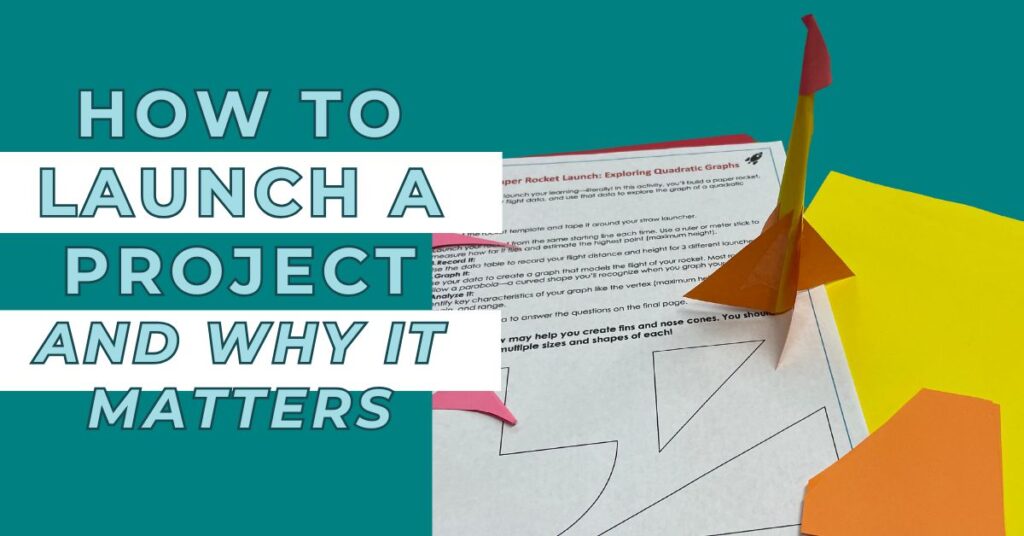Why is a project launch successful for a PBL Unit?
Look, I know you’re not new to project-based learning. You’ve read the research, seen the Pinterest boards, and probably even downloaded a few PBL freebies.
But let’s be real—if your last project didn’t go quite the way you hoped… it might be because you skipped one of the most important steps: the project launch.
Next thing you know, the vibe is off, students are confused, and the project flops before it even begins.
Don’t worry, that’s what this post (and I!) are here for.
I’m going to break down exactly what a project launch is, why it’s essential for every successful PBL unit, and how to plan one that hooks your students and sets the stage for deep, meaningful learning.
What Is a Project Launch?
At its most basic, a project launch is the moment you introduce a new project to your students. But it’s more than just handing out a packet or putting slides on the board– its a key secret to PBL success.
It’s the spark that gets students curious. It’s how you get them to lean in, ask questions, and buy in to the journey ahead.
Let’s zoom out a little: A great project launch often includes an engaging problem, a real-world scenario, or a surprising hook that builds context and relevance. Sometimes it even includes a guest speaker, a video, or a hands-on challenge.
At a more advanced level, teachers use launches to introduce project parameters, essential questions, roles, timelines, and the public product—laying a strong foundation for student success.
If you’re new to this step, don’t worry. You’ll get better at it over time (and your students will start to expect and crave it). 
Want a cheat sheet? Check out my Gold Standard Project Planner—it includes a quick-start guide to planning launches that work.
Why Should You Care About a Project Launch?
You might be thinking, “Can’t I just dive into the project?” Technically yes, but let me give you three solid reasons to rethink that:
-
It prevents project fails. So many projects flop simply because students weren’t given the “why” or the “how” up front. A strong launch builds clarity and motivation.
-
It increases engagement. The best project launches create an emotional or intellectual hook that sticks. That hook = curiosity = higher participation.
-
It sets expectations and builds momentum. A launch helps establish the tone for collaboration, the purpose of the work, and the final outcome. This early clarity keeps students on track.
Important: Don’t fall for the myth that “just doing a fun project” is enough. Without a clear launch, students often miss the deeper purpose and the learning feels shallow.
The truth is: A great project needs a great launch to succeed.
Project Launch in Action
Let me show you how this works in a real math classroom:
When I launch my Rocket Project (a quadratic functions unit), we kick off with a teaser video from a real NASA engineer, show a rocket launch demo on the football field, and ask: How can we design a rocket that will hit a target?
That single question gets kids asking all the right things:
-
How high can it go?
-
How does launch angle affect distance?
-
How can we model this with math?
That’s the power of a launch—it creates curiosity and ownership before any formulas are introduced.
One of my students once said: “This was the first time I actually wanted to know what the equation was.”
That’s the goal.
Want to see how this plays out? Grab my [free mini Rocket Launch performance task here].
4 Tips for Launching Your Next Project
Still feeling stuck? I got you. Here are some tried-and-true tips to help you launch like a pro:
1. Start with a hook. This could be a challenge, a short video, a problem to solve, or even a physical object. Make them wonder.
2. Connect to the real world. Use a current event, career connection, or authentic problem to make the work feel relevant.
3. Preview the journey. Help students see the path ahead: What will they create? Who will see it? How will they be assessed?
4. Give them a role. Make it feel like a mission, not just an assignment. Frame them as engineers, consultants, or creative designers.
For even more support, check out my PBL Kickstart Mini Course. It walks you through planning an entire project launch from scratch.
Key Takeaways
Let’s wrap it up. The key things to remember:
-
A project launch isn’t optional—it’s essential.
-
A good launch can prevent failure, boost engagement, and guide students through a meaningful learning journey.
-
With the right tools and structure, any teacher can launch a project like a pro.
At Moore Than Just X, I help math teachers design real-world projects that actually work—without burning out in the process.
Want to learn more? Drop me a line in the Modern Math Teacher Facebook Group or DM me on Instagram.
P.S. Don’t forget to grab your free Rocket Launch Task [link] and check out the Gold Standard Project Planner to start your next project off right.










